Mary Quattlebaum's Blog, page 27
August 5, 2013
WHATEVER THE WEATHER WRITING FUN
by Ashley Alison Formento
You may visit exciting new places or spend time seeing family on summer vacation. Wherever you travel, you're bound to hear: "It's hot!" or "It's rainy." You might even hear, "It's August! Why is it so cool outside?" Something everyone in this world has in common is the weather. "A dark and stormy night" is a famous story beginning from a novel (Paul Clifford) written in the 1800's, and setting a scene using weather is no less important in fiction and non-fiction books today. Try these writing challenges anytime of the year for some weather writing fun.
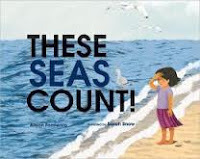
Sizzling SummerIt's the hottest day on record. Write one page about the hottest day of the year without using the word "hot." It's harder than you think.
Brrrrr!Icy, snowy, cold. Think about the coldest you've ever felt in your life. Write one paragraph to make readers shiver.
Falling LeavesWhoosh, it's windy! Why do some leaves fall and others don't? Choose a tree in your yard or near your school. Can you find out what kind of tree it is? Do the leaves change and fall in the autumn? Write an autumn poem about this tree.
Flower ShowerSpring, green, rain. What puts the bounce in spring for you? Do you splash in the puddles or avoid them? Do flowers make you smile or make you sneeze? It's the first day of spring and you're going to plant a garden. Write a description about this new spring day and details about what you're planting and why.
http://alisonashleyformento.com/
You may visit exciting new places or spend time seeing family on summer vacation. Wherever you travel, you're bound to hear: "It's hot!" or "It's rainy." You might even hear, "It's August! Why is it so cool outside?" Something everyone in this world has in common is the weather. "A dark and stormy night" is a famous story beginning from a novel (Paul Clifford) written in the 1800's, and setting a scene using weather is no less important in fiction and non-fiction books today. Try these writing challenges anytime of the year for some weather writing fun.

Sizzling SummerIt's the hottest day on record. Write one page about the hottest day of the year without using the word "hot." It's harder than you think.
Brrrrr!Icy, snowy, cold. Think about the coldest you've ever felt in your life. Write one paragraph to make readers shiver.
Falling LeavesWhoosh, it's windy! Why do some leaves fall and others don't? Choose a tree in your yard or near your school. Can you find out what kind of tree it is? Do the leaves change and fall in the autumn? Write an autumn poem about this tree.
Flower ShowerSpring, green, rain. What puts the bounce in spring for you? Do you splash in the puddles or avoid them? Do flowers make you smile or make you sneeze? It's the first day of spring and you're going to plant a garden. Write a description about this new spring day and details about what you're planting and why.
http://alisonashleyformento.com/
Published on August 05, 2013 14:00
July 29, 2013
WRITING AND COMMON CORE CONNECTIONS WITH SUSAN STOCKDALE
by Mary Quattlebaum
 Schools are abuzz with talk of Common Core. What are the challenges for students, teachers of writing, and those who write for children? How might the new standards be best implemented to enhance writing as well as reading and information-processing skills? In exploring these questions, I’m delighted to welcome acclaimed author/illustrator Susan Stockdale to Pencil Tips. When it comes to nonfiction, Susan embraces beauty and accuracy. Her books on the natural world, including her newest, Stripes (Peachtree 2013), are scrupulously researched and stunningly presented, both in terms of language and image. Check www.susanstockdale.com for more information on Susan’s books and activities.
Schools are abuzz with talk of Common Core. What are the challenges for students, teachers of writing, and those who write for children? How might the new standards be best implemented to enhance writing as well as reading and information-processing skills? In exploring these questions, I’m delighted to welcome acclaimed author/illustrator Susan Stockdale to Pencil Tips. When it comes to nonfiction, Susan embraces beauty and accuracy. Her books on the natural world, including her newest, Stripes (Peachtree 2013), are scrupulously researched and stunningly presented, both in terms of language and image. Check www.susanstockdale.com for more information on Susan’s books and activities.
1. Your new book, Stripes, is in the style of your award-winning titles Bring on the Birds and Fabulous Fishes, with back matter that helps the book to grow with the reader. Can you share your greatest joy in writing and illustrating it?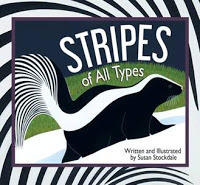 2. What about your biggest challenge?
2. What about your biggest challenge?
My biggest challenge was deciding which animal to illustrate for each line of text. I had many choices. For example, for my line “poised on a leaf,” I illustrated a zebra swallowtail butterfly, but I considered a Colorado potato beetle, a leafhopper, a red shield bug, a bumblebee, a caterpillar and other creatures. I chose the butterfly because I thought it was the most visually appealing of all my candidates and would be fun to paint - an important consideration!Here is the progression of my badger illustration:
Sketch 1: the badger that is "prowling the prairie" looks pretty meek here!
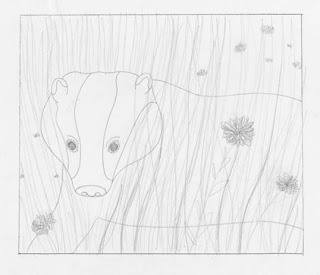
Sketch 2: now the badger looks more like it's prowling

Image 3: final acrylic painting

3. Thank you for sharing the evolution of that particular image! It’s fascinating to see how you add ever-greater detail to the depiction of the badger and its habitat. Do you have a writing or drawing prompt that might connect with the book?
As a fun and easy warm-up exercise, I give children a sticky note and ask them to write an adjective describing a photo or painting we are observing. (There’s something about writing just one word on a little piece of paper that takes the intimidation out of writing.) Then I gather up the notes and ask the children to direct me as I arrange and rearrange their words on the wall. The results can be surprising and sometimes beautifully poetic. This prompt demonstrates how changing the order of words changes their meaning, and how a small change can make a big difference.
Thank you, Susan. I know you’re already hard at work on your next nonfiction book, Spots, and look forward to sharing that one with my students, too.
www.maryquattlebaum.com
 Schools are abuzz with talk of Common Core. What are the challenges for students, teachers of writing, and those who write for children? How might the new standards be best implemented to enhance writing as well as reading and information-processing skills? In exploring these questions, I’m delighted to welcome acclaimed author/illustrator Susan Stockdale to Pencil Tips. When it comes to nonfiction, Susan embraces beauty and accuracy. Her books on the natural world, including her newest, Stripes (Peachtree 2013), are scrupulously researched and stunningly presented, both in terms of language and image. Check www.susanstockdale.com for more information on Susan’s books and activities.
Schools are abuzz with talk of Common Core. What are the challenges for students, teachers of writing, and those who write for children? How might the new standards be best implemented to enhance writing as well as reading and information-processing skills? In exploring these questions, I’m delighted to welcome acclaimed author/illustrator Susan Stockdale to Pencil Tips. When it comes to nonfiction, Susan embraces beauty and accuracy. Her books on the natural world, including her newest, Stripes (Peachtree 2013), are scrupulously researched and stunningly presented, both in terms of language and image. Check www.susanstockdale.com for more information on Susan’s books and activities.1. Your new book, Stripes, is in the style of your award-winning titles Bring on the Birds and Fabulous Fishes, with back matter that helps the book to grow with the reader. Can you share your greatest joy in writing and illustrating it?
 2. What about your biggest challenge?
2. What about your biggest challenge?My biggest challenge was deciding which animal to illustrate for each line of text. I had many choices. For example, for my line “poised on a leaf,” I illustrated a zebra swallowtail butterfly, but I considered a Colorado potato beetle, a leafhopper, a red shield bug, a bumblebee, a caterpillar and other creatures. I chose the butterfly because I thought it was the most visually appealing of all my candidates and would be fun to paint - an important consideration!Here is the progression of my badger illustration:
Sketch 1: the badger that is "prowling the prairie" looks pretty meek here!

Sketch 2: now the badger looks more like it's prowling

Image 3: final acrylic painting

3. Thank you for sharing the evolution of that particular image! It’s fascinating to see how you add ever-greater detail to the depiction of the badger and its habitat. Do you have a writing or drawing prompt that might connect with the book?
As a fun and easy warm-up exercise, I give children a sticky note and ask them to write an adjective describing a photo or painting we are observing. (There’s something about writing just one word on a little piece of paper that takes the intimidation out of writing.) Then I gather up the notes and ask the children to direct me as I arrange and rearrange their words on the wall. The results can be surprising and sometimes beautifully poetic. This prompt demonstrates how changing the order of words changes their meaning, and how a small change can make a big difference.
Thank you, Susan. I know you’re already hard at work on your next nonfiction book, Spots, and look forward to sharing that one with my students, too.
www.maryquattlebaum.com
Published on July 29, 2013 14:00
July 22, 2013
SUMMER PICTURES: USING GOOGLE IMAGE AS A WRITING TOOL
by Jacqueline Jules
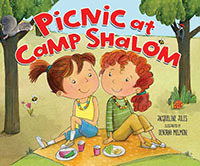 When I began writing my picture book, Picnic at Camp Shalom, I had a problem. For marketing reasons, my editor requested a summer camp setting. While I agreed that my story of friendship and misunderstandings would work well at a summer camp, I panicked. My childhood memories of summer camp were dim, at best. Was there a way I could boost my recollection of an experience I had nearly 40 years ago? Yes, there was! Google searches provided information on summer camp programs complete with pictures and testimonies. My research taught me that a swim test is a typical first day activity. This gave me my opening scene in which my protagonists, Carly and Sara, meet at the lake. Later, I read that scavenger hunts are popular for getting new campers acquainted with the grounds, giving me material for the second scene in the book.
When I began writing my picture book, Picnic at Camp Shalom, I had a problem. For marketing reasons, my editor requested a summer camp setting. While I agreed that my story of friendship and misunderstandings would work well at a summer camp, I panicked. My childhood memories of summer camp were dim, at best. Was there a way I could boost my recollection of an experience I had nearly 40 years ago? Yes, there was! Google searches provided information on summer camp programs complete with pictures and testimonies. My research taught me that a swim test is a typical first day activity. This gave me my opening scene in which my protagonists, Carly and Sara, meet at the lake. Later, I read that scavenger hunts are popular for getting new campers acquainted with the grounds, giving me material for the second scene in the book.
While a random internet search may not be a good source for collecting facts for nonfiction writing, it can offer great assistance for developing descriptive details. Google Images provided just the picture I needed when trying to visualize the cabin Carly and Sara slept in. I often use Google images to prod me into better descriptions. Staring at a picture for a few minutes can help me imagine my character’s surroundings.
Before you ask your students to write about their summer vacations, display pictures of beaches, swimming pools, fireworks, and other summer scenarios on your classroom screen. Talk about the sensory details these images evoke. What does the sand feel like between your toes? Did you see sand crabs disappearing into tiny holes? How did the water smell? Did the shiny pool rails gleam in the sun? How would you describe the sound of people diving off the board? Could you compare it to anything else?
As a pre-writing activity, have your students study the details of displayed pictures and discuss ways of describing them. Figurative language requires thought. Giving your students a little time to visualize the scenes they plan to write about will enliven their writing.
www,jacquelinejules.com
 When I began writing my picture book, Picnic at Camp Shalom, I had a problem. For marketing reasons, my editor requested a summer camp setting. While I agreed that my story of friendship and misunderstandings would work well at a summer camp, I panicked. My childhood memories of summer camp were dim, at best. Was there a way I could boost my recollection of an experience I had nearly 40 years ago? Yes, there was! Google searches provided information on summer camp programs complete with pictures and testimonies. My research taught me that a swim test is a typical first day activity. This gave me my opening scene in which my protagonists, Carly and Sara, meet at the lake. Later, I read that scavenger hunts are popular for getting new campers acquainted with the grounds, giving me material for the second scene in the book.
When I began writing my picture book, Picnic at Camp Shalom, I had a problem. For marketing reasons, my editor requested a summer camp setting. While I agreed that my story of friendship and misunderstandings would work well at a summer camp, I panicked. My childhood memories of summer camp were dim, at best. Was there a way I could boost my recollection of an experience I had nearly 40 years ago? Yes, there was! Google searches provided information on summer camp programs complete with pictures and testimonies. My research taught me that a swim test is a typical first day activity. This gave me my opening scene in which my protagonists, Carly and Sara, meet at the lake. Later, I read that scavenger hunts are popular for getting new campers acquainted with the grounds, giving me material for the second scene in the book.While a random internet search may not be a good source for collecting facts for nonfiction writing, it can offer great assistance for developing descriptive details. Google Images provided just the picture I needed when trying to visualize the cabin Carly and Sara slept in. I often use Google images to prod me into better descriptions. Staring at a picture for a few minutes can help me imagine my character’s surroundings.
Before you ask your students to write about their summer vacations, display pictures of beaches, swimming pools, fireworks, and other summer scenarios on your classroom screen. Talk about the sensory details these images evoke. What does the sand feel like between your toes? Did you see sand crabs disappearing into tiny holes? How did the water smell? Did the shiny pool rails gleam in the sun? How would you describe the sound of people diving off the board? Could you compare it to anything else?
As a pre-writing activity, have your students study the details of displayed pictures and discuss ways of describing them. Figurative language requires thought. Giving your students a little time to visualize the scenes they plan to write about will enliven their writing.
www,jacquelinejules.com
Published on July 22, 2013 14:00
July 15, 2013
LIBRARIES OF LOVE
by Joan Waites
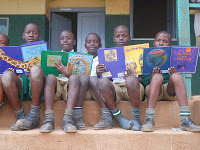 I must admit, I have a love-hate relationship with social media. While Facebook and Twitter can be entertaining and a great way to connect with friends and colleagues, it can also be a huge source of distraction. A five minute “check-in” can easily slip away into a half hour of wasted surfing. But once in a while, something wonderful pops up on your screen which makes that surfing time worthwhile.Last week, a photo appeared on my Facebook “wall”, posted by a publisher I have worked for. A group of boys from Uganda, proudly displayed books they were reading. One of the boys held a title I illustrated a few years ago. The photo was taken by an organization I had not heard about before-Libraries of Love. From the Libraries of Lovewebsite:
I must admit, I have a love-hate relationship with social media. While Facebook and Twitter can be entertaining and a great way to connect with friends and colleagues, it can also be a huge source of distraction. A five minute “check-in” can easily slip away into a half hour of wasted surfing. But once in a while, something wonderful pops up on your screen which makes that surfing time worthwhile.Last week, a photo appeared on my Facebook “wall”, posted by a publisher I have worked for. A group of boys from Uganda, proudly displayed books they were reading. One of the boys held a title I illustrated a few years ago. The photo was taken by an organization I had not heard about before-Libraries of Love. From the Libraries of Lovewebsite:
“Libraries of Love collects books, prepares them forcheckout with pockets and cards, and ships them toUganda. A team of volunteers then travels to Uganda,There are several ways to help out this worthy organization. Along with donating funds, information about organizing book drives can be found on their website: http://www.librariesoflove.org/
If you are searching for a new service project to do with your students, Scouts, clubs or homeschoolers next year, this would be a terrific opportunity to give the gift of reading to children in need.
www.joanwaites.com
 I must admit, I have a love-hate relationship with social media. While Facebook and Twitter can be entertaining and a great way to connect with friends and colleagues, it can also be a huge source of distraction. A five minute “check-in” can easily slip away into a half hour of wasted surfing. But once in a while, something wonderful pops up on your screen which makes that surfing time worthwhile.Last week, a photo appeared on my Facebook “wall”, posted by a publisher I have worked for. A group of boys from Uganda, proudly displayed books they were reading. One of the boys held a title I illustrated a few years ago. The photo was taken by an organization I had not heard about before-Libraries of Love. From the Libraries of Lovewebsite:
I must admit, I have a love-hate relationship with social media. While Facebook and Twitter can be entertaining and a great way to connect with friends and colleagues, it can also be a huge source of distraction. A five minute “check-in” can easily slip away into a half hour of wasted surfing. But once in a while, something wonderful pops up on your screen which makes that surfing time worthwhile.Last week, a photo appeared on my Facebook “wall”, posted by a publisher I have worked for. A group of boys from Uganda, proudly displayed books they were reading. One of the boys held a title I illustrated a few years ago. The photo was taken by an organization I had not heard about before-Libraries of Love. From the Libraries of Lovewebsite:“Libraries of Love collects books, prepares them forcheckout with pockets and cards, and ships them toUganda. A team of volunteers then travels to Uganda,There are several ways to help out this worthy organization. Along with donating funds, information about organizing book drives can be found on their website: http://www.librariesoflove.org/
If you are searching for a new service project to do with your students, Scouts, clubs or homeschoolers next year, this would be a terrific opportunity to give the gift of reading to children in need.
www.joanwaites.com
Published on July 15, 2013 14:00
July 8, 2013
DEAR AUTHOR
by Mary Amato
 Writing a letter to an author is a wonderful way for a child to connect. What you want, though, is for the child to receive a letter in return. To make sure this happens, you need to have the correct address. Sometimes authors have contact information on their websites. Often this is just an email address. While email can be quick, sending and receiving snail mail can be much more meaningful. Snail mail addresses are harder to find, but there are a few tricks to make the experience more successful. Here is a info sheet that explains the dos and don'ts for contacting an author. Share this with a child and give it a try.http://www.maryamato.com/how-to-write-to-an-author
Writing a letter to an author is a wonderful way for a child to connect. What you want, though, is for the child to receive a letter in return. To make sure this happens, you need to have the correct address. Sometimes authors have contact information on their websites. Often this is just an email address. While email can be quick, sending and receiving snail mail can be much more meaningful. Snail mail addresses are harder to find, but there are a few tricks to make the experience more successful. Here is a info sheet that explains the dos and don'ts for contacting an author. Share this with a child and give it a try.http://www.maryamato.com/how-to-write-to-an-author
 Writing a letter to an author is a wonderful way for a child to connect. What you want, though, is for the child to receive a letter in return. To make sure this happens, you need to have the correct address. Sometimes authors have contact information on their websites. Often this is just an email address. While email can be quick, sending and receiving snail mail can be much more meaningful. Snail mail addresses are harder to find, but there are a few tricks to make the experience more successful. Here is a info sheet that explains the dos and don'ts for contacting an author. Share this with a child and give it a try.http://www.maryamato.com/how-to-write-to-an-author
Writing a letter to an author is a wonderful way for a child to connect. What you want, though, is for the child to receive a letter in return. To make sure this happens, you need to have the correct address. Sometimes authors have contact information on their websites. Often this is just an email address. While email can be quick, sending and receiving snail mail can be much more meaningful. Snail mail addresses are harder to find, but there are a few tricks to make the experience more successful. Here is a info sheet that explains the dos and don'ts for contacting an author. Share this with a child and give it a try.http://www.maryamato.com/how-to-write-to-an-author
Published on July 08, 2013 14:00
July 1, 2013
WHAT LIES IN OUR MEMORIES?
by Jane Harrington
Just returned from a writing extravaganza in Ireland—part retreat in the remote reaches of the island, part bustling residency at Dublin’s Trinity College. In the conversations with the myriad writers I got to know over the weeks, there was a recurring theme that has followed me back across the Atlantic and sits with me now at my writing desk. Many of these Irish writers (all well established in Europe and some highly acclaimed here in the States, as well) told stories of being afraid to write as children. Insecurity, guilt, shame—all of these feelings seemed to be seated in a childhood belief that if they wrote creatively or fantastically about their lives, families, friends, they were somehow telling lies. Mostly fiction writers, these talented wordsmiths were adults before they came to realize that good writing naturally springs from the everyday, and they wish they’d allowed the young versions of themselves more freedom to explore the boundaries between life and art.
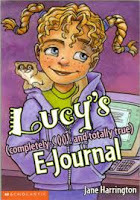 It was with pangs of understanding that I listened to their regrets, because I, too, quashed my urge to write when I was a child, and for the same reasons. What utterly wasted time, I think now, my most successful fiction having been forged from the “real” stuff that filled the days of my own children’s lives. My first novel for kids, Lucy’s Completely Cool and Totally True E-Journal, was strongly based on our family’s experience having my mother-in-law with Alzheimer’s disease come live with us, and that book sold 150,000 copies in Scholastic Book Fairs and generated a great fan buzz when it came out in 2001. (Now out of print, you can get it for pennies at Amazon orSo, I’d like to share a few memory exercises that might help some young writers gain confidence in using their own real-life stories as ore for imagining the deeper truths that, well, lie in fiction. (Aren’t words fun?!)
It was with pangs of understanding that I listened to their regrets, because I, too, quashed my urge to write when I was a child, and for the same reasons. What utterly wasted time, I think now, my most successful fiction having been forged from the “real” stuff that filled the days of my own children’s lives. My first novel for kids, Lucy’s Completely Cool and Totally True E-Journal, was strongly based on our family’s experience having my mother-in-law with Alzheimer’s disease come live with us, and that book sold 150,000 copies in Scholastic Book Fairs and generated a great fan buzz when it came out in 2001. (Now out of print, you can get it for pennies at Amazon orSo, I’d like to share a few memory exercises that might help some young writers gain confidence in using their own real-life stories as ore for imagining the deeper truths that, well, lie in fiction. (Aren’t words fun?!)
1. Describe in detail a room in your family’s home. Include every bit of furniture, every picture on the walls. Then have a visitor arrive from another planet.2. Write a memory of your favorite relative, only imagine her/him in the form of your favorite animal.3. Step into a scene where a friend or sibling is in your kitchen, laughing. What has happened? What is going to happen?4. Quickly list all the people you can think of who like to wear hats, and describe the hats.5. Among your friends, who has hands or feet you really like? Explain what it is you like about those hands or feet.6. Open your refrigerator and study what is in there for a minute. Then close the door and try to describe every item you remember, including details about the shapes and colors of the packaging. (Don’t peek! If you can’t recall something, make it up!) Now have the foods interact behind the closed door.
www.janeharrington.com
Just returned from a writing extravaganza in Ireland—part retreat in the remote reaches of the island, part bustling residency at Dublin’s Trinity College. In the conversations with the myriad writers I got to know over the weeks, there was a recurring theme that has followed me back across the Atlantic and sits with me now at my writing desk. Many of these Irish writers (all well established in Europe and some highly acclaimed here in the States, as well) told stories of being afraid to write as children. Insecurity, guilt, shame—all of these feelings seemed to be seated in a childhood belief that if they wrote creatively or fantastically about their lives, families, friends, they were somehow telling lies. Mostly fiction writers, these talented wordsmiths were adults before they came to realize that good writing naturally springs from the everyday, and they wish they’d allowed the young versions of themselves more freedom to explore the boundaries between life and art.
 It was with pangs of understanding that I listened to their regrets, because I, too, quashed my urge to write when I was a child, and for the same reasons. What utterly wasted time, I think now, my most successful fiction having been forged from the “real” stuff that filled the days of my own children’s lives. My first novel for kids, Lucy’s Completely Cool and Totally True E-Journal, was strongly based on our family’s experience having my mother-in-law with Alzheimer’s disease come live with us, and that book sold 150,000 copies in Scholastic Book Fairs and generated a great fan buzz when it came out in 2001. (Now out of print, you can get it for pennies at Amazon orSo, I’d like to share a few memory exercises that might help some young writers gain confidence in using their own real-life stories as ore for imagining the deeper truths that, well, lie in fiction. (Aren’t words fun?!)
It was with pangs of understanding that I listened to their regrets, because I, too, quashed my urge to write when I was a child, and for the same reasons. What utterly wasted time, I think now, my most successful fiction having been forged from the “real” stuff that filled the days of my own children’s lives. My first novel for kids, Lucy’s Completely Cool and Totally True E-Journal, was strongly based on our family’s experience having my mother-in-law with Alzheimer’s disease come live with us, and that book sold 150,000 copies in Scholastic Book Fairs and generated a great fan buzz when it came out in 2001. (Now out of print, you can get it for pennies at Amazon orSo, I’d like to share a few memory exercises that might help some young writers gain confidence in using their own real-life stories as ore for imagining the deeper truths that, well, lie in fiction. (Aren’t words fun?!)1. Describe in detail a room in your family’s home. Include every bit of furniture, every picture on the walls. Then have a visitor arrive from another planet.2. Write a memory of your favorite relative, only imagine her/him in the form of your favorite animal.3. Step into a scene where a friend or sibling is in your kitchen, laughing. What has happened? What is going to happen?4. Quickly list all the people you can think of who like to wear hats, and describe the hats.5. Among your friends, who has hands or feet you really like? Explain what it is you like about those hands or feet.6. Open your refrigerator and study what is in there for a minute. Then close the door and try to describe every item you remember, including details about the shapes and colors of the packaging. (Don’t peek! If you can’t recall something, make it up!) Now have the foods interact behind the closed door.
www.janeharrington.com
Published on July 01, 2013 14:00
June 24, 2013
WRITING CONNECTIONS WITH KAREN LEGGETT ABOURAYA
by Mary Quattlebaum
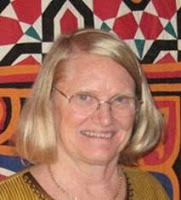 I’m delighted to welcome Karen Leggett Abouraya to Pencil Tips. Karen is a long-time champion of children’s books and literacy and first-time co-author, with Susan L. Roth, of
Hands Around the Library
(Dial 2012), an inspiring nonfiction account of people coming together to protect the great library of Alexandria during the 2011 Egyptian revolution. Karen reflects on the joys and challenges of writing and offers a prompt to jumpstart youngsters’ thinking about their own civic engagement. The book’s back matter and Susan’s website www.susanlroth.com include information on the international “Let’s Hold Hands” art project, which encourages children to create and share their own self-portrait collaged paper dolls. This could be a wonderful project for the classroom or home.
I’m delighted to welcome Karen Leggett Abouraya to Pencil Tips. Karen is a long-time champion of children’s books and literacy and first-time co-author, with Susan L. Roth, of
Hands Around the Library
(Dial 2012), an inspiring nonfiction account of people coming together to protect the great library of Alexandria during the 2011 Egyptian revolution. Karen reflects on the joys and challenges of writing and offers a prompt to jumpstart youngsters’ thinking about their own civic engagement. The book’s back matter and Susan’s website www.susanlroth.com include information on the international “Let’s Hold Hands” art project, which encourages children to create and share their own self-portrait collaged paper dolls. This could be a wonderful project for the classroom or home.
1. I loved reading about a community acting together to ensure the continuation of a library. It seems that libraries are one of the most important (and cost-effective) ways to foster a love of reading and to ensure the availability of books for everyone. What was your greatest joy in writing Hands Around the Library? My greatest joy was finding the opportunity to write a compelling story about modern Egypt – and collaborating with a good friend to do it (acclaimed illustrator and collage artist Susan Roth). Children know all about pyramids and mummies and the Sphinx, but we tend to forget that Egypt is full of people living busy and interesting lives today.
My greatest joy was finding the opportunity to write a compelling story about modern Egypt – and collaborating with a good friend to do it (acclaimed illustrator and collage artist Susan Roth). Children know all about pyramids and mummies and the Sphinx, but we tend to forget that Egypt is full of people living busy and interesting lives today.
Here are Karen and Susan in one of Susan’s collage illustrations for the book.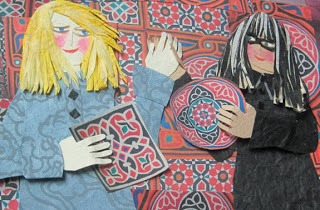 2. Has the book had an impact internationally?
2. Has the book had an impact internationally?
The book has provided an opportunity to share both similarities and differences in the lives of American and Egyptian kids. During a Skype session between students in Alexandria, Virginia, and Alexandria, Egypt, one American boy asked the Egyptian children, “What’s your favorite food?” An Egyptian girl said, “Pizza and hamburgers.” It may have been one of the more significant questions of the day because it reminded these kids that they are more alike than different.
3. What was your greatest challenge in writing the book?
The biggest challenge was making sure we stayed true to what actually happened during the revolution in Egypt in 2011. The “goosebumps” in this story come not so much from a sense of imminent danger as from seeing so many diverse people – rich and poor, Muslim and Christian, young and old – holding hands to save one community institution they all cherished. We worked hard to give that message top priority in the story.
4. Your school visits galvanize much discussion. Do you have a writing prompt that might connect with the book?
I have conversations, more than writing exercises, with students, but this question would work as a writing prompt as well. The most interesting discussions have been generated when I ask, “What place in your community is so special that you would work hard to save it if it were going to be damaged or destroyed?” The answers have ranged from the local animal shelter to a local park to the students’ school and homes to Chuck E. Cheese (yes, that was the very first answer I received to this question!). Then we talk about what you might do to save that place – especially if you are one kid or a group of kids – making signs, writing letters, organizing friends, gathering petitions, etc. I’ve had some great discussions with kids on these issues of civic engagement.
Thank you, Karen! Your prompt got me thinking about ways to save and strengthen libraries in the United States, many of which have been hit hard by budget cuts.
www.maryquattlebaum.com
 I’m delighted to welcome Karen Leggett Abouraya to Pencil Tips. Karen is a long-time champion of children’s books and literacy and first-time co-author, with Susan L. Roth, of
Hands Around the Library
(Dial 2012), an inspiring nonfiction account of people coming together to protect the great library of Alexandria during the 2011 Egyptian revolution. Karen reflects on the joys and challenges of writing and offers a prompt to jumpstart youngsters’ thinking about their own civic engagement. The book’s back matter and Susan’s website www.susanlroth.com include information on the international “Let’s Hold Hands” art project, which encourages children to create and share their own self-portrait collaged paper dolls. This could be a wonderful project for the classroom or home.
I’m delighted to welcome Karen Leggett Abouraya to Pencil Tips. Karen is a long-time champion of children’s books and literacy and first-time co-author, with Susan L. Roth, of
Hands Around the Library
(Dial 2012), an inspiring nonfiction account of people coming together to protect the great library of Alexandria during the 2011 Egyptian revolution. Karen reflects on the joys and challenges of writing and offers a prompt to jumpstart youngsters’ thinking about their own civic engagement. The book’s back matter and Susan’s website www.susanlroth.com include information on the international “Let’s Hold Hands” art project, which encourages children to create and share their own self-portrait collaged paper dolls. This could be a wonderful project for the classroom or home.1. I loved reading about a community acting together to ensure the continuation of a library. It seems that libraries are one of the most important (and cost-effective) ways to foster a love of reading and to ensure the availability of books for everyone. What was your greatest joy in writing Hands Around the Library?
 My greatest joy was finding the opportunity to write a compelling story about modern Egypt – and collaborating with a good friend to do it (acclaimed illustrator and collage artist Susan Roth). Children know all about pyramids and mummies and the Sphinx, but we tend to forget that Egypt is full of people living busy and interesting lives today.
My greatest joy was finding the opportunity to write a compelling story about modern Egypt – and collaborating with a good friend to do it (acclaimed illustrator and collage artist Susan Roth). Children know all about pyramids and mummies and the Sphinx, but we tend to forget that Egypt is full of people living busy and interesting lives today.Here are Karen and Susan in one of Susan’s collage illustrations for the book.
 2. Has the book had an impact internationally?
2. Has the book had an impact internationally?The book has provided an opportunity to share both similarities and differences in the lives of American and Egyptian kids. During a Skype session between students in Alexandria, Virginia, and Alexandria, Egypt, one American boy asked the Egyptian children, “What’s your favorite food?” An Egyptian girl said, “Pizza and hamburgers.” It may have been one of the more significant questions of the day because it reminded these kids that they are more alike than different.
3. What was your greatest challenge in writing the book?
The biggest challenge was making sure we stayed true to what actually happened during the revolution in Egypt in 2011. The “goosebumps” in this story come not so much from a sense of imminent danger as from seeing so many diverse people – rich and poor, Muslim and Christian, young and old – holding hands to save one community institution they all cherished. We worked hard to give that message top priority in the story.
4. Your school visits galvanize much discussion. Do you have a writing prompt that might connect with the book?
I have conversations, more than writing exercises, with students, but this question would work as a writing prompt as well. The most interesting discussions have been generated when I ask, “What place in your community is so special that you would work hard to save it if it were going to be damaged or destroyed?” The answers have ranged from the local animal shelter to a local park to the students’ school and homes to Chuck E. Cheese (yes, that was the very first answer I received to this question!). Then we talk about what you might do to save that place – especially if you are one kid or a group of kids – making signs, writing letters, organizing friends, gathering petitions, etc. I’ve had some great discussions with kids on these issues of civic engagement.
Thank you, Karen! Your prompt got me thinking about ways to save and strengthen libraries in the United States, many of which have been hit hard by budget cuts.
www.maryquattlebaum.com
Published on June 24, 2013 14:00
June 17, 2013
FUN WITH TITLES
by Jacqueline Jules
When I talk about the publishing process at author visits, audiences are frequently surprised to learn that writers don’t necessarily choose the titles of their books. Authors make suggestions, but the publishing house has final say over what a book will be called. Editors and marketing people often reject titles based on concerns that a certain title will negatively affect sales. A good title peaks interest just like an attractive book cover. Serious thought should go into choosing just the right title to make your book stand out on crowded bookstore shelves.
This doesn’t mean, however, a young writer should spend hours mulling over a title before writing the first sentence. I usually advise young writers to brainstorm ideas for the perfect name after their writing is complete. Sometimes choosing a title can inspire a young author to revise a story. For example, if the piece is called “My Day at Busch Gardens,” maybe the story should include more details of the theme park than the road trip to Williamsburg and the food each family member ate at a restaurant along the way.
Thinking about a title and what it reveals about a story is a good way to focus a narrative. A fun way to practice this is to use a list of titles as writing prompts. Give your students the following list of titles and add some of your own. Ask them to choose a title and come up with a story that clearly reflects the suggested topic.
A Tale of Two Tigers
The Snail and the Snake
A New Beginning
The Door to Winter
Summer on a Spaceship
The Monster Under the Bed
Two Brave Friends
www.jacquelinejules.com
When I talk about the publishing process at author visits, audiences are frequently surprised to learn that writers don’t necessarily choose the titles of their books. Authors make suggestions, but the publishing house has final say over what a book will be called. Editors and marketing people often reject titles based on concerns that a certain title will negatively affect sales. A good title peaks interest just like an attractive book cover. Serious thought should go into choosing just the right title to make your book stand out on crowded bookstore shelves.
This doesn’t mean, however, a young writer should spend hours mulling over a title before writing the first sentence. I usually advise young writers to brainstorm ideas for the perfect name after their writing is complete. Sometimes choosing a title can inspire a young author to revise a story. For example, if the piece is called “My Day at Busch Gardens,” maybe the story should include more details of the theme park than the road trip to Williamsburg and the food each family member ate at a restaurant along the way.
Thinking about a title and what it reveals about a story is a good way to focus a narrative. A fun way to practice this is to use a list of titles as writing prompts. Give your students the following list of titles and add some of your own. Ask them to choose a title and come up with a story that clearly reflects the suggested topic.
A Tale of Two Tigers
The Snail and the Snake
A New Beginning
The Door to Winter
Summer on a Spaceship
The Monster Under the Bed
Two Brave Friends
www.jacquelinejules.com
Published on June 17, 2013 14:00
June 10, 2013
SUMMER SUNSHINE: BIBLIOTHERAPY
by Alison Ashley Formento
Summer vacation is on everyone’s mind and students and teachers are looking forward to fun with family and friends. Unfortunately, this isn’t the case for everyone. Victims of recent tornadoes in Oklahoma face a different summer reality. Storms and other traumatic losses are a more regular occurrence, or perhaps it’s how our news cycles are 24/7. Authors receive steady requests to donate books to charity raffles and to help rebuild library and school collections. We readily give our books, knowing that those rebuilding new homes or schools will need books to help with their healing process.
Bibliotherapy involves finding books that will help someone heal from a trauma or gain an understanding of an aspect of their personality or issue that is occurring in their life. According to the ODLIS, Online Dictionary for Library and Information Science, bibliotherapy is traditionally defined as a planned reading program designed to facilitate the recovery of patients suffering from mental illness or emotional disturbance.
SEND A BOOK AND A SMILE: Bibliotheraphy at the classroom level
Every year, teachers and students clean out their classrooms before summer vacation. This year, take that classroom clean-up one step further.
1. Together, as a classroom, choose an organization you’d like to help, such as the Oklahoma Red Cross, Books for Africa, a local family with a parent serving in the military, or a family shelter in your area.2. Choose a classroom book (or books*) that you read aloud and discuss together. *Books might also come from student donations.3. Every student writes a short letter about what they enjoyed in this book. Encourage them to write something about their own school experience, too.4. Include a happy classroom photo for the children or organization they are writing to in this special care package.5. Wrap the book and letters. 6. Students can draw a small picture on the packing envelope before it is mailed. 7. Student could bring in a quarter (if possible) to help with mailing costs.8. Send some summer sunshine with this book and letter package to help a community in need.
www.alisonashleyformento.com
Summer vacation is on everyone’s mind and students and teachers are looking forward to fun with family and friends. Unfortunately, this isn’t the case for everyone. Victims of recent tornadoes in Oklahoma face a different summer reality. Storms and other traumatic losses are a more regular occurrence, or perhaps it’s how our news cycles are 24/7. Authors receive steady requests to donate books to charity raffles and to help rebuild library and school collections. We readily give our books, knowing that those rebuilding new homes or schools will need books to help with their healing process.
Bibliotherapy involves finding books that will help someone heal from a trauma or gain an understanding of an aspect of their personality or issue that is occurring in their life. According to the ODLIS, Online Dictionary for Library and Information Science, bibliotherapy is traditionally defined as a planned reading program designed to facilitate the recovery of patients suffering from mental illness or emotional disturbance.
SEND A BOOK AND A SMILE: Bibliotheraphy at the classroom level
Every year, teachers and students clean out their classrooms before summer vacation. This year, take that classroom clean-up one step further.
1. Together, as a classroom, choose an organization you’d like to help, such as the Oklahoma Red Cross, Books for Africa, a local family with a parent serving in the military, or a family shelter in your area.2. Choose a classroom book (or books*) that you read aloud and discuss together. *Books might also come from student donations.3. Every student writes a short letter about what they enjoyed in this book. Encourage them to write something about their own school experience, too.4. Include a happy classroom photo for the children or organization they are writing to in this special care package.5. Wrap the book and letters. 6. Students can draw a small picture on the packing envelope before it is mailed. 7. Student could bring in a quarter (if possible) to help with mailing costs.8. Send some summer sunshine with this book and letter package to help a community in need.
www.alisonashleyformento.com
Published on June 10, 2013 14:00
June 3, 2013
POST IT!: FIGHTING THE BLANK PAGE
by Mary Amato

Young reluctant writers are often turned off or afraid of the blank page. I made up an imagination game involving Post-it notes that gets kids excited. Give each child ten blank sticky notes. Tell your class that you are all going to create a new language by labeling ordinary things in the room with sticky notes. Each child has to choose ten objects in the room and invent new words for those things. Emphasize that you should be able to pronounce the new language. Let's use the clock as an example. In my new language I might label the clock, "hitzer." Kids will realize the importance of vowels! Set a time limit for the labeling and when kids are done writing the labels let them put the labels on the objects. Take a group tour of the room, practicing how to say each new word. I created this game as a teacher after remembering the fun I had as a child trying to invent my own language. The new words gave rise to lots of stories about my newly invented culture. Have fun!
www.maryamato.com

Young reluctant writers are often turned off or afraid of the blank page. I made up an imagination game involving Post-it notes that gets kids excited. Give each child ten blank sticky notes. Tell your class that you are all going to create a new language by labeling ordinary things in the room with sticky notes. Each child has to choose ten objects in the room and invent new words for those things. Emphasize that you should be able to pronounce the new language. Let's use the clock as an example. In my new language I might label the clock, "hitzer." Kids will realize the importance of vowels! Set a time limit for the labeling and when kids are done writing the labels let them put the labels on the objects. Take a group tour of the room, practicing how to say each new word. I created this game as a teacher after remembering the fun I had as a child trying to invent my own language. The new words gave rise to lots of stories about my newly invented culture. Have fun!
www.maryamato.com
Published on June 03, 2013 14:00
Mary Quattlebaum's Blog
- Mary Quattlebaum's profile
- 22 followers
Mary Quattlebaum isn't a Goodreads Author
(yet),
but they
do have a blog,
so here are some recent posts imported from
their feed.



